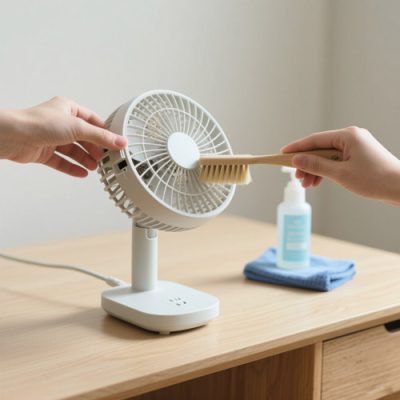Yes, you heard that right—even a common household electric fan needs proper maintenance and storage. Taking good care of your fan when it’s not in use can extend its lifespan and reduce the chance of malfunctions when you bring it out again next summer.
Cleaning and Maintenance
Fan Cover and Blades
Before cleaning, make sure the fan is completely unplugged. Detach the fan guard and blades, then wipe them with a soft cloth using warm water or a mild detergent to remove dust, grease, and any buildup. Once clean, let them air dry or dry with a cloth before reassembling.
Motor Housing
Since the motor should not come into contact with water, use a dry cloth or a hair dryer on the cool setting to blow off dust. If you have machine oil or a suitable lubricant at home, you can add a few drops into the motor’s lubrication port to keep it running smoothly.
Storage Tips
Choose a Dry, Ventilated Area
Avoid storing your fan in damp or humid environments, which can cause the motor to absorb moisture or the internal wiring to corrode or short-circuit. Also keep it away from direct sunlight or heat sources to prevent plastic deformation.
Use a Dust Cover
If you still have the fan’s original packaging, place the fan back in the box and seal it for storage. If not, wrap it in a clean cloth, dustproof bag, or plastic cover to protect it from dust and moisture.
Disassemble if Needed
For fans with detachable parts, consider separating the base, stand, and fan head to save space and prevent warping during storage.
Important Reminders
- Ensure the fan is completely dry before storing to prevent mold or rust.
- Inspect the power cord for signs of damage or aging. If needed, repair or replace before storage.
- Consider taking the fan out every 2–3 months for ventilation and a quick wipe-down to avoid long-term pressure or moisture buildup.
Frequently Asked Questions
1. Can I store my electric fan in the attic or garage during the off-season?
While attics and garages are common storage areas, they are often subject to extreme temperature changes and high humidity. This can damage the motor, warp plastic parts, or cause rust. If possible, store your fan in a dry, climate-controlled indoor space to maintain its condition.
2. Do I need to oil my fan before storing it?
Not all fans require lubrication, especially sealed motor models. However, if your fan has a designated oil port or the manual recommends occasional lubrication, it’s a good idea to apply a few drops of machine oil before storage. This helps keep the motor components in smooth working order when the fan is used again.
Signzworld’s Tip:
Proper maintenance isn’t just for high-end appliances—even everyday tools like electric fans deserve regular care. Whether you’re a household user or a reseller of home appliances, knowing how to extend product longevity through simple steps like these can make a big difference in user satisfaction.



